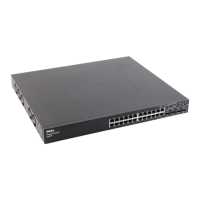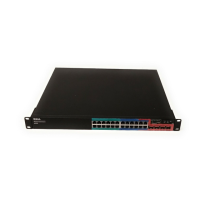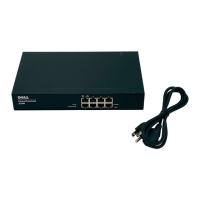170 Utility
Switch Stack MAC Addressing and Stack Design Considerations
The switch stack uses the MAC addresses
1
assigned to the management unit. If the backup unit assumes
control due to a management unit failure or warm restart, the backup unit continues to use the original
management unit’s MAC addresses. This reduces the amount of disruption to the network because ARP
and other L2 entries in neighbor tables remain valid after the failover to the backup unit.
Stack units should always be connected with a ring topology (or other biconnected topology), so that the
loss of a single stack link does not divide the stack into multiple stacks. If a stack is partitioned such that
some units lose all connectivity to other units, then both parts of the stack start using the same MAC
addresses. This can cause severe problems in the network.
If you move the management unit of stack to a different place in the network, make sure you power down
the whole stack before you redeploy the management unit so that the stack members do not continue to
use the MAC address of the redeployed switch.
NSF Network Design Considerations
You can design your network to take maximum advantage of NSF. For example, by distributing a LAG's
member ports across multiple units, the stack can quickly switch traffic from a port on a failed unit to a
port on a surviving unit. When a unit fails, the forwarding plane of surviving units removes LAG
members on the failed unit so that it only forwards traffic onto LAG members that remain up. If a LAG
is left with no active members, the LAG goes down. To prevent a LAG from going down, configure LAGs
with members on multiple units within the stack, when possible. If a stack unit fails, the system can
continue to forward on the remaining members of the stack.
If your switch stack performs VLAN routing, another way to take advantage of NSF is to configure
multiple "best paths" to the same destination on different stack members. If a unit fails, the forwarding
plane removes Equal Cost Multipath (ECMP) next hops on the failed unit from all unicast forwarding
table entries. If the cleanup leaves a route without any next hops, the route is deleted. The forwarding
plane only selects ECMP next hops on surviving units. For this reason, try to distribute links providing
ECMP paths across multiple stack units.
NSF Default Behavior
NSF is enabled by default. You can disable NSF in order to redirect the CPU resources consumed by data
checkpointing. Checkpointing only occurs when a backup unit is elected, so there is no need to disable
the NSF feature on a standalone switch. When a new unit is added to the stack, the new unit takes the
configuration of the stack, including the NSF setting.
1. Each switch is assigned four consecutive MAC addresses. The system uses the first three MAC addresses for the service port,
network port, and routing interfaces. The fourth MAC address is reserved for future use. A stack of switches uses the four
MAC addresses.assigned to the management unit.

